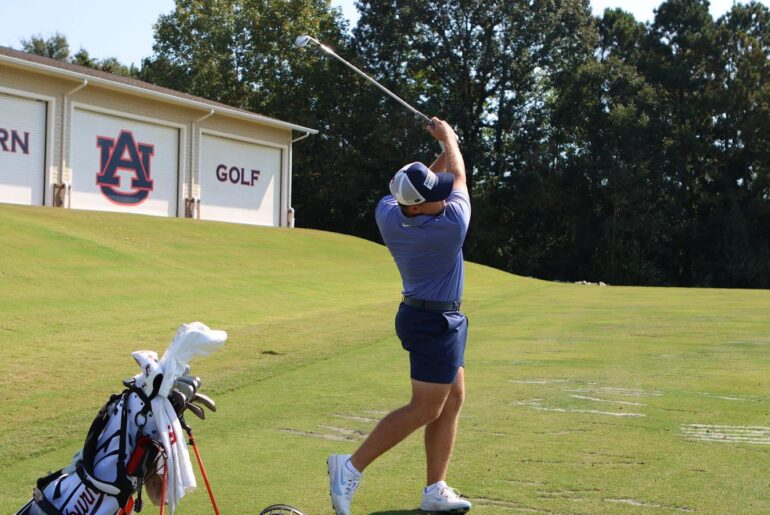
(Photo by Jason Finn on Shutterstock)
In a nutshell
Living within 1 mile of a golf course more than doubles your risk of developing Parkinson’s disease compared to living over 6 miles away.
People getting drinking water from municipal systems that include golf courses face almost twice the risk compared to those in water service areas without golf courses.
The danger is highest in areas with “vulnerable groundwater” where pesticides can easily seep into water supplies.
PHOENIX — That beautiful view of green fairways might be hiding a dangerous secret: people who live near golf courses face a much higher risk of developing Parkinson’s disease.
Recent findings published in JAMA Network Open reveal residents within a mile of a golf course have more than double the risk of Parkinson’s compared to those living beyond six miles away. The risk seems especially high for folks whose drinking water comes from municipal systems that include golf courses, particularly in regions with vulnerable groundwater.
The Golf Course Connection
A research team headed by Brittany Krzyzanowski from the Barrow Neurological Institute in Phoenix investigated whether the heavy pesticide use on American golf courses—up to 15 times higher than in European countries—might be causing increased Parkinson’s rates among nearby residents.
“The greatest risk of Parkinson’s disease was found within 1 to 3 miles of a golf course and risk generally decreased with distance,” the authors write.
About 23% of America’s 16,000 golf courses are part of residential or real estate communities, according to the National Golf Foundation. But this new research raises concerns that golf course homes might expose residents to chemicals linked to this serious brain disorder.
Parkinson’s disease affects nearly a million Americans and ranks as the second most common brain-degenerative disorder after Alzheimer’s. Sufferers experience tremors, slow movement, and thinking problems that worsen over time. While genes cause some cases, scientists have long suspected environmental exposures—especially pesticides—are major culprits.

Many golf courses across America are lined with beautiful homes. Researchers warn these residential communities may not be as picture-perfect as homeowners believe. (Photo by Jason Finn on Shutterstock)
Distance and Water: Key Risk Factors
Krzyzanowski’s team examined data from 419 Parkinson’s patients diagnosed in Olmsted County, Minnesota, between 1991 and 2015, comparing them with more than 5,000 similar people without the disease.
Using detailed maps, researchers measured how far each person lived from the nearest of 139 golf courses in the region. People living within a mile of a golf course showed 126% higher risk of Parkinson’s than those living beyond six miles. Residents between one and two miles away had nearly triple the risk.
Water sources turned out to be critical. The study found that “Individuals living within water service areas with a golf course had nearly double the odds of PD compared with individuals in water service areas without golf courses and 49% greater odds compared with individuals with private wells.”
The danger peaked in areas with “vulnerable groundwater”—places with coarse soil, shallow bedrock, or karst geology where chemicals easily seep into water supplies. The research showed that “individuals living in water service areas with a golf course in vulnerable groundwater regions had 82% greater odds of developing Parkinson’s disease compared with those in nonvulnerable groundwater regions.”
Pesticides: The Likely Culprit
“For years pesticides including organophosphates, chlorpyrifos, methylchlorophenoxypropionic acid (MCPP), 2,4-dichlorophenoxyacetic acid (2,4-D), maneb, and organochlorines, known to be associated with the development of PD, have been used to treat golf courses,” the study explains.
Lab studies have shown these substances can cause Parkinson’s-like brain cell death, mainly through damaging brain cells that produce dopamine, a chemical essential for movement control.
Golf courses require perfect, weed-free conditions. According to the research, “in the U.S., pesticide application to golf courses can be up to 15 times higher compared with countries in Europe.”
One particularly worrying finding showed that 90% of people living within three miles of a golf course also lived within water service areas using groundwater, meaning they likely drank from the same potentially contaminated source.
Researchers think exposure happens through two main paths: contaminated drinking water and airborne chemicals. The study observed stronger effects in urban areas, suggesting that denser development around city golf courses might lead to higher airborne pesticide exposure for nearby homes.
What This Means For You
For millions of Americans living near golf courses, these discoveries force a new calculation weighing pretty views against potential health risks. The researchers suggest that “public health policies to reduce the risk of groundwater contamination and airborne exposure from pesticides on golf courses may help reduce risk of PD in nearby neighborhoods.”
Before signing papers on that perfect home with fairway views, you might want to consider what invisible chemicals are drifting into your air and water.
Paper Summary
Methodology
This case-control study used data from the Rochester Epidemiology Project medical records system, identifying 419 patients diagnosed with Parkinson’s disease in Olmsted County, Minnesota between 1991 and 2015. Researchers matched these patients with 5,113 controls without Parkinson’s. Golf course locations were collected from Esri Business Analyst for 139 courses in the 27-county study region, and researchers calculated the distance from each participant’s residence to the nearest golf course. They also gathered data on water service areas, groundwater vulnerability, and municipal well locations to investigate drinking water as a potential exposure route. The study used logistic regression models adjusted for age, sex, race, ethnicity, income, urban/rural classification, and healthcare utilization to assess the relationship between golf course proximity and Parkinson’s risk.
Results
Living within 1 mile of a golf course was associated with 126% increased odds of developing Parkinson’s compared to living more than 6 miles away (adjusted odds ratio 2.26). People living 1-2 miles away had nearly triple the odds (aOR 2.98), while those 2-3 miles away had 121% higher odds (aOR 2.21). The risk decreased with distance beyond 3 miles. Additionally, people living in water service areas with a golf course had almost double the odds of Parkinson’s compared to those in areas without golf courses (aOR 1.96) and 49% greater odds compared to those with private wells (aOR 1.49). The risk was particularly high in vulnerable groundwater regions with a golf course, with 82% greater odds compared to non-vulnerable regions with a golf course (aOR 1.82).
Limitations
The study had a limited geographical extent and included a predominantly white population, potentially limiting generalizability. Researchers didn’t have information on occupational history, which could lead to exposure misclassification if participants spent significant time away from home. Other relevant risk factors like head trauma or genetic predisposition weren’t considered. Golf course location data was from 2013, which provides only a minimal exposure window given Parkinson’s long prodromal period. The researchers also note that requiring Parkinson’s cases to have an Olmsted County residence at diagnosis was a limitation, though sensitivity analyses using only Olmsted County controls showed consistent results.
Funding/Disclosures
The study was supported by the National Institute on Aging, the National Institute of Neurological Disorders and Stroke, the Parkinson’s Disease Foundation, Acadia Pharmaceuticals, and the Michael J. Fox Foundation. Dr. Dorsey, a co-author, reported receiving honoraria, consulting fees, and grants from numerous organizations including Abbvie, Acadia, Biogen, and the Michael J. Fox Foundation. Dr. Bower reported grants from Novartis and Amylyx Pharmaceuticals outside the submitted work.
Publication Information
The paper “Proximity to Golf Courses and Risk of Parkinson Disease” was published in JAMA Network Open on May 8, 2025 (Volume 8, Issue 5, article e259198). The authors are Brittany Krzyzanowski, Aidan F. Mullan, E. Ray Dorsey, Sai Shivani Chirag, Pierpaolo Turcano, Emanuele Camerucci, James H. Bower, and Rodolfo Savica.hael J. Fox Foundation, among others.







